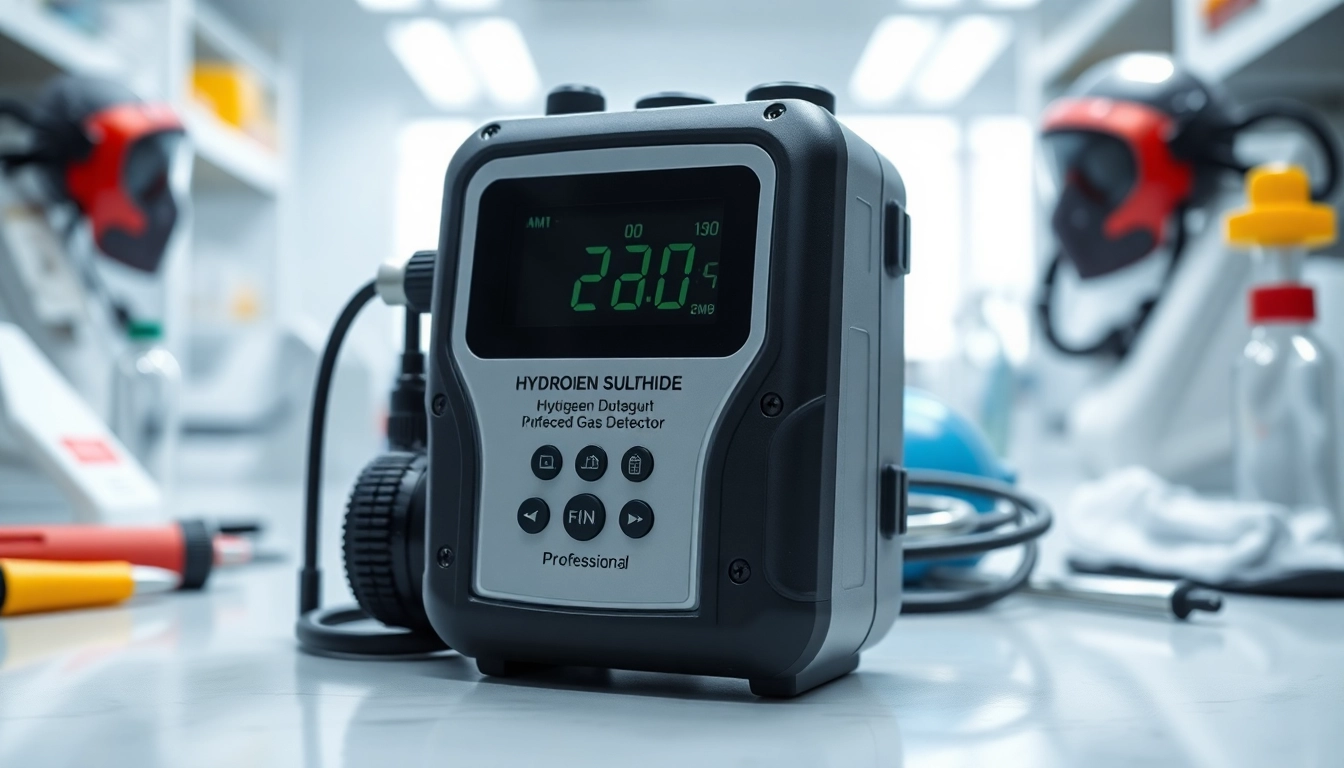
Understanding Hydrogen Sulfide Gas Hazards
Hydrogen sulfide (H₂S) is a colorless gas known for its distinctive rotten egg smell. While typically found in low concentrations, it can pose severe dangers under specific conditions. Understanding the hazards associated with hydrogen sulfide is crucial for industries that may encounter this substance, including oil and gas, sewage treatment, and manufacturing. This article will delve into the various aspects surrounding hydrogen sulfide, from health risks to effective detection methods. For optimal safety, the deployment of a reliable Hydrogen Sulfide gas detector is imperative.
Sources and Occurrences of Hydrogen Sulfide
Hydrogen sulfide occurs naturally from various sources. One of the primary sources is the decomposition of organic matter by bacteria in environments lacking oxygen. This process is evident in swamps, sewers, and during petroleum extraction. Furthermore, hydrogen sulfide can be released during industrial activities, including the processing of fossil fuels and the production of chemicals.
In domestic settings, hydrogen sulfide may accumulate in poorly ventilated basements or during specific plumbing issues, such as the rotting of sewage and organic material. Certain geographical regions also see more frequent occurrences of hydrogen sulfide gas due to volcanic activity or geothermal processes.
Health Risks Associated with Hydrogen Sulfide Exposure
Exposure to hydrogen sulfide can have serious health consequences. At low concentrations (up to 10 parts per million), it can cause irritation to the eyes and respiratory tract. At moderate exposure levels (20-50 parts per million), victims may experience more profound symptoms, including headaches, dizziness, and nausea. High concentrations of hydrogen sulfide (above 100 parts per million) can lead to more serious health effects, including loss of consciousness and even death within minutes.
Chronic exposure, even at lower concentrations, can result in long-term health challenges, such as damage to the eyes, respiratory problems, and neurological effects. Given these risks, the monitoring and detection of hydrogen sulfide are paramount in ensuring workplace and public safety.
Regulatory Standards for Hydrogen Sulfide Detection
Several regulatory organizations have established guidelines for the detection and permissible levels of hydrogen sulfide in the workplace. The Occupational Safety and Health Administration (OSHA) in the United States sets a limit of 20 parts per million as a permissible exposure limit (PEL) over an 8-hour workday. The National Institute for Occupational Safety and Health (NIOSH) has also published guidelines emphasizing the importance of contingency plans and robust gas detection systems in environments where hydrogen sulfide may be present. Compliance with these regulations is essential for safeguarding employee health and avoiding penalties.
Key Features of Effective Hydrogen Sulfide Gas Detectors
Choosing a gas detector is not a one-size-fits-all approach. Ideal hydrogen sulfide gas detectors possess specific features that ensure both efficiency and reliability in monitoring hazardous environments.
Sensor Technology and Sensitivity
The sensor technology utilized in hydrogen sulfide detectors significantly impacts their efficacy. Electrochemical sensors are favored for their sensitivity and precision. These sensors undergo a chemical reaction to detect the presence of hydrogen sulfide, providing accurate readings even at low concentrations. Additionally, infrared sensors can be useful in specific industrial scenarios, particularly where high concentrations are expected.
When evaluating detectors, consider their sensitivity levels and response times. A quick response is crucial in emergency situations to alert personnel when dangerous concentrations are present. Ideally, detectors should have a sensitivity below 1 parts per million to provide timely alerts before dangerous levels are reached.
Battery Life and Portability Features
For environments where hydrogen sulfide detection may be critical and mobile, battery life and portability become fundamental features. A gas detector should offer a long battery life, ideally exceeding 24 hours of continuous operation on a single charge. This ensures that the device remains functional during extended shifts or in inaccessible locations.
Portability is enhanced through lightweight materials and ergonomic design, allowing ease of transport for fieldwork. Some manufacturers also provide options that feature clips or carrying holsters for convenience during heavy-duty activities.
Data Logging and Connectivity Options
Modern hydrogen sulfide detectors frequently include data logging capabilities that can track exposure levels over time. This feature plays a crucial role for facility managers in analyzing trends related to gas exposure, implementing preventive measures, and ensuring compliance with regulatory standards.
Connectivity options, such as Bluetooth or wireless integration, allow data to be synced with cloud-based applications or facility management systems. This enhances the sharing and analysis of critical safety data across teams and stakeholders, making it easier to manage safety protocols and respond to incidents swiftly.
How to Choose the Best Hydrogen Sulfide Gas Detector
Selecting the ideal hydrogen sulfide detector requires thoughtful consideration, as various factors can influence the appropriateness of a device for specific environments and applications.
Identifying Your Specific Needs and Environment
The first step in choosing a hydrogen sulfide gas detector is to assess the environment where it will be deployed. For example, industrial applications may require robust detectors capable of withstanding extreme conditions, such as high temperatures, humidity, or corrosive substances. In contrast, portable personal detectors may need to focus on lightweight designs and ease of use.
Moreover, consider the likelihood of exposure to hydrogen sulfide in your specific applications. Static work environments such as wastewater treatment plants may necessitate fixed gas detection systems, while construction sites or oil fields could benefit from portable options.
Evaluating Manufacturer Compliance and Certifications
When selecting a hydrogen sulfide gas detector, ensuring that the manufacturer adheres to industry regulations and standards is critical. Look for certifications such as ATEX, IECEx, or UL. These certifications indicate that the products have undergone rigorous testing and meet specific safety standards. Additionally, manufacturers should provide clear information on their warranty, reliability, and maintenance services, underscoring their commitment to customer safety.
Cost vs. Quality Considerations
While budget considerations are essential, opting for the least expensive hydrogen sulfide detector could lead to dire consequences in the long term. Investing in high-quality gas detectors reduces the risks associated with equipment failure and ensures safety compliance. Evaluate different models based on their features, reliability, and the long-term cost of ownership, which includes maintenance, calibration, and potential replacements.
Best Practices for Using Hydrogen Sulfide Gas Detectors
Having suitable hydrogen sulfide gas detectors is only part of the equation. Effective usage also involves adherence to best practices that ensure optimal performance and safety.
Regular Maintenance and Calibration Procedures
To maintain accuracy, hydrogen sulfide gas detectors require regular maintenance and calibration. Professional services may include checking sensor accuracy, replacing batteries, and replacing worn components. Depending on manufacturer recommendations, calibration procedures may be necessary at least once annually or whenever the device shows signs of malfunction. Keeping logs of maintenance and calibration activities will also ensure compliance with regulatory standards.
Training Personnel on Detector Use
Providing comprehensive training on the operation of hydrogen sulfide detectors is vital for personnel safety. Workers should be well-informed on how to operate the detectors, understand alarm signals, and respond appropriately in emergencies. Conduct regular training sessions and drills to ensure all personnel are prepared for potential hydrogen sulfide exposure scenarios. This proactive approach not only enhances safety but also fosters a culture of awareness and responsibility among employees.
Responding to Alarm Responses Effectively
Having a detector is insufficient if personnel do not know how to react when alarms are triggered. Establish clear procedures for responding to hydrogen sulfide alarms, which should include immediate evacuation protocols, reporting procedures, and communication plans. Regularly review and practice these emergency protocols to ensure personnel can respond swiftly and effectively during actual incidents.
Analyzing Performance Metrics in Hydrogen Sulfide Detection
After implementing a hydrogen sulfide detection system, it is crucial to analyze performance metrics to assess effectiveness and compliance. Evaluating these insights helps organizations improve safety measures and optimize protocols over time.
Key Performance Indicators for Gas Detectors
Key performance indicators (KPIs) for hydrogen sulfide gas detectors can include response time, false alarm rates, sensitivity levels, and calibration frequency. Monitoring these KPIs allows organizations to pinpoint potential weaknesses in their detection systems and make informed decisions regarding upgrades or corrective actions.
For example, consistently high false alarm rates may suggest a need for sensor recalibration, while prolonged response times might indicate a malfunction or require review of operational protocols.
Comparing Detector Outcomes Across Environments
Implementing a consistent methodology for analyzing detector outcomes across various environments offers valuable insights. Comparing results in different environments can help identify trends, discern patterns in hydrogen sulfide detection, and determine how environmental factors impact detection performance. Understanding these dynamics fosters an adaptive safety culture where practices can be refined based on real-world data.
Innovations in Hydrogen Sulfide Detection Technologies
The realm of hydrogen sulfide detection continues to evolve, with emerging technologies enhancing safety measures. Innovations such as remote monitoring, smart detection systems, and advanced sensor technologies have transformed how industries approach gas detection. Devices embedded with artificial intelligence (AI) can learn environmental patterns and predict potential gas leaks before they occur, providing an additional layer of safety.
Staying informed about technological advancements in gas detection ensures that organizations can leverage new solutions to enhance current practices, thus securing a safer work environment for all personnel.







